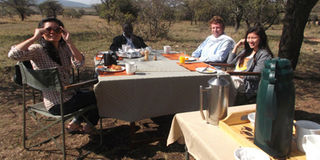Conservancies could help end poaching

Enjoying breakfast after an early morning game drive at Porini Bush Camp in the Ol Kinyei Conservancy. People living on small parcels of land should be encouraged to consolidate their land into wildlife conservancies. This way, they can benefit from tourism proceeds while helping protect wildlife habitat. PHOTO/FILE.
What you need to know:
- This way, they can make wildlife conservation one of their main sources of livelihood.
- Gamewatchers Safaris’ Manager Ms Chantal Migongo-Bake says this is the potential remedy for runaway poaching incidents in the country.
- She said Maasai families who hold individual titles for small portions of land should be discouraged from using the land for agricultural activities.
- The Porini Conservancy concept calls for communally-owned wildlife conservancies funded by eco-tourism.
Pastoralist communities holding individual title deeds for small parcels of land next to national parks and reserves should consolidate them for establishment of conservancies.
Gamewatchers Safaris’ Manager in charge of Conservation and Corporate Social Responsibility Ms Chantal Migongo-Bake said communities must be allowed to benefit from wildlife proceeds earned within their midst so as to make wildlife conservation one of their main sources of livelihood.
She says this is the potential remedy for the runaway poaching incidents being experienced in the country.
Ms Migongo-Bake said stakeholders in the tourism industry must look for urgent ways to change the lifestyles of people living next to wildlife sanctuaries if Kenya is to enjoy increased numbers of tourism arrivals.
POACHERS MENACE
She was commenting on the runaway killings of elephants and rhinos by poachers for their tusks and horns.
“Securing wildlife habitats in various ecosystems throughout the country demand that we strive to improve relations between communities and wildlife by creating career opportunities for owners of the conservancies,” said Migongo-Bake.
Gamewatchers Safaris’ celebrated Porini Conservancy concept started by Jake Grieves-Cook first attracted 85 Maasai families into consolidating their individual parcels for exclusive use by wild animals.
This led to the establishment of Ol Kinyei conservancy on 9,800 acres and subsequent opening of a small high end tented camp to generate income from tourism.
The success of the community model has since attracted more herders which has seen Ol Kinyei Conservancy’s acreage increase its size to 17,500 acres.
“The families earn monthly returns for their respective land contribution in addition to employment opportunities reserved for their children.
They further benefit from a newly created bursary fund by conservationists for local children,” she said.
BUFFER ZONES
Ms Migongo-Bake said through their flagships, Selenkay Conservancy in Amboseli (1997) and Ol Kinyei Conservancy in the Maasai Mara (2005), they had helped change lives of locals while providing an example for other communal groups holding individual titles to form conservancies thereby creating a buffer zone owned by individual residents.
Similar projects have been carried out in Northern Kenya leading to consolidation of 27 community areas into conservancies that have brought one million acres under one regime. This has in turn enhanced security and boosted tourism revenue for betterment of livelihoods.
Biting poverty among people residing next to wildlife conservancies continue to deal a severe blow to Kenya’s tourism as witnessed last Month when six elephants in Tsavo West National Park were shot dead.
Ms Migongo-Bake said tourism numbers and haphazard licensing of new lodges must be controlled to reduce ongoing degradation on forage.
Multiple off-road tracks that adversely affect security of wildlife and tourists within the Maasai Mara National Reserve must also be controlled.
LOSS OF WILDLIFE HABITAT
She said Maasai families who hold individual titles for small portions of land should be discouraged from using the land for agricultural activities saying this led to loss of wildlife habitat followed by significant decreases in wildlife populations.
This trend could adversely affect availability of a buffer zone for the world famous Maasai Mara National Reserve known as home to the world’s Eighth wonder - the annual wildebeest migration across Mara River.
To safeguard the future of wildlife as well as the wellbeing of residents, there was a need for conservation-minded safari operators to join in supporting the edge-families to exclusively set aside large tracts of communal land for wildlife.
The Porini Conservancy concept calls for communally-owned wildlife conservancies funded by eco-tourism.
This should bring together representatives of the families occupying the designated area to pool their individual holdings in order to create a wildlife habitat within which human habitation and cultivation of crops is suspended.
At the same time, grazing of livestock is strictly controlled, for an agreed minimum number of years whereby the families earn handsome returns.





